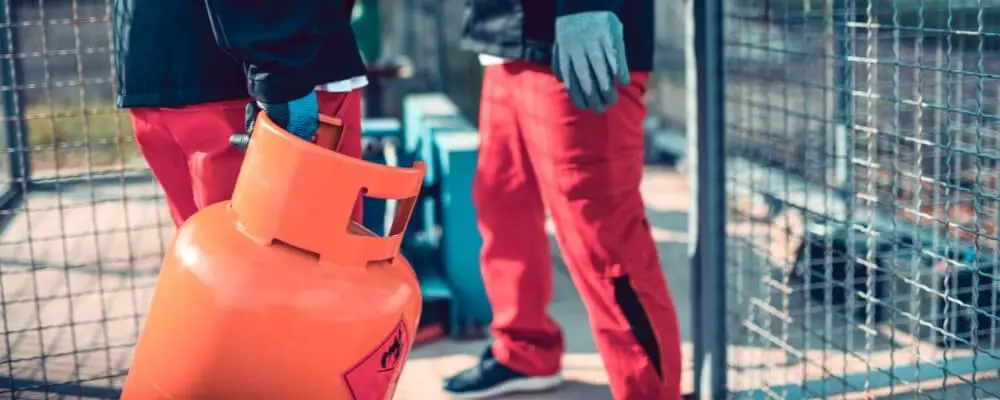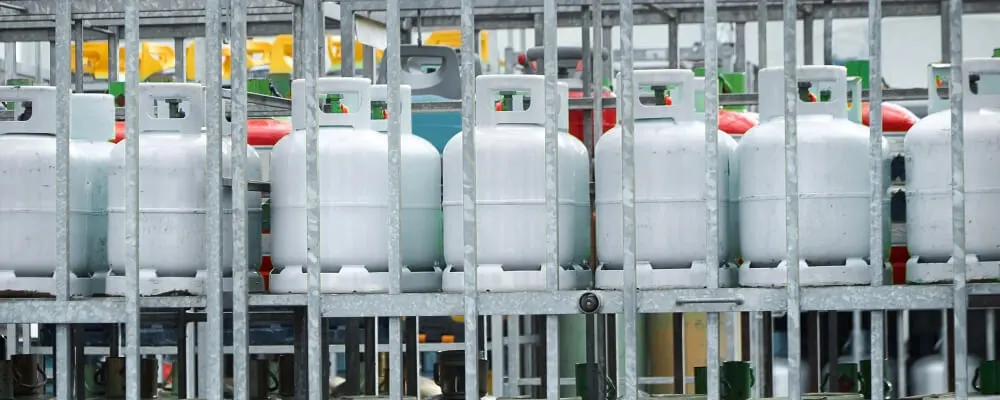Safety remains a cornerstone of operational excellence in today’s fast-paced industrial environment. One of the often-overlooked aspects of workplace safety is the storage of gas cylinders. These seemingly innocuous metal containers, filled with various gases under high pressure, can pose significant risks if not handled or stored properly. The stakes are undeniably high, from the threat they present to human life to their potential impact on the environment.
With this in mind, we’ve curated a list of 10 essential tips to ensure that cylinders are stored safely in the workplace. Whether you’re a safety officer, an operations manager, or simply an employee looking to enhance safety measures in your environment, this guide will offer invaluable insights to foster a safer, more compliant workspace. Dive in and discover best practices that safeguard lives and property and underscore a commitment to a comprehensive safety culture.
Why It’s Important To Store Cylinders Safely?
Storing cylinders safely is paramount for a multitude of reasons, which span across the protection of human life, property, and the environment:
- Protection of Human Life: The most immediate concern with improperly stored cylinders is their threat to human life. Cylinders contain gases under high pressure. If a cylinder is damaged, there’s a risk of rapid gas release, turning the cylinder into a dangerous projectile. Additionally, the gas itself, depending on its nature, might be toxic, flammable, or oxygen-displacing, posing direct health risks such as poisoning, combustion, or suffocation.
- Prevention of Property Damage: Accidents involving gas cylinders can lead to fires, explosions, or structural damage, especially if the contained gas is flammable. The subsequent damage can destroy equipment, buildings, or other valuable assets. The costs associated with repairs, replacements, and downtime can be substantial.
- Environmental Concerns: Some gases, if released, can harm the environment. For example, releasing refrigerants can deplete the ozone layer, while some greenhouse gases exacerbate global warming. Safe storage ensures these gases remain contained, reducing the risk of environmental harm.
- Compliance with Regulations: Many regions have specific regulations and standards concerning the storage of pressurized cylinders. Non-compliance can lead to legal ramifications, fines, and even the shutdown of operations.
- Economic Implications: Apart from the direct costs of property damage, accidents can lead to downtime in operations, affecting a company’s profitability. There’s also the potential cost of litigation if employees or members of the public are harmed due to negligence.
- Reputation Management: An accident due to improper cylinder storage can harm the reputation of a business. The negative publicity surrounding such events can erode customer, partner, and public trust.
- Ensuring Quality of Contents: Safe storage conditions ensure that the gas inside the cylinder maintains its purity and effectiveness. Exposing cylinders to extreme temperatures or contaminants can compromise the quality of the contained gas.
- Promotion of Safety Culture: Proper cylinder storage is part of a broader safety culture. When organizations prioritize and implement safe storage practices, it underscores a commitment to safety at all levels, fostering a culture where safety becomes a shared responsibility among all employees.
In essence, the safe storage of cylinders is not just about preventing immediate dangers but also about ensuring the holistic well-being of people, assets, and the environment. It’s a proactive approach that offers both immediate and long-term benefits.

10 Essential Tips For Safely Cylinder Storage In The Workplace
Storing cylinders safely in the workplace is critical, as improper storage can lead to dangerous situations, including gas leaks, fires, and explosions. Here are 10 essential tips for safely storing cylinders in the workplace:
1. Proper Labeling and Identification
The clarity and legibility of labels on cylinders are of paramount importance. Without the right label, users might misuse the gases, leading to catastrophic events, especially if they are flammable, toxic, or reactive. Labels are an immediate identifier and a crucial information source, providing data about the gas’s properties, potential hazards, and handling precautions.
In emergencies, first responders can quickly determine the potential risks and take appropriate actions based on these labels. Ensuring every cylinder is correctly and clearly labeled is an essential first step in cylinder safety.
2. Upright Storage
Storing cylinders in an upright position is vital for several reasons. One of the main concerns is the functionality of the pressure relief devices. These are typically designed to work when the cylinder is upright, and if a cylinder is lying down, the device might not function as intended.
Furthermore, if the cylinder contains a liquid gas, lying it horizontally could cause the liquid to block the pressure relief valve, preventing it from operating correctly. An upright position also reduces the risk of the cylinder rolling, which can lead to physical injuries or damage to the cylinder’s valve.
3. Secure Them
The physical security of gas cylinders cannot be overlooked. Given their high internal pressures, a fallen or knocked-over cylinder can become a projectile, endangering everyone in its path. Chains, straps, and specially designed clamps are more than just securing measures; they are critical safety tools.
The chance of accidental knocks increases, especially in busy environments where people constantly move or in areas with heavy machinery operations. By securing the cylinders, workplaces can significantly reduce potential hazards from such inadvertent incidents.
4. Separation of Full and Empty Cylinders
An organized storage system separating full from empty cylinders offers multiple benefits. Firstly, it streamlines operations as workers can quickly identify which cylinders are ready for use and which need to be returned or refilled.
But more importantly, this distinction can be lifesaving in situations requiring rapid decisions, such as emergencies. A simple tagging system or designated areas can efficiently achieve this separation, ensuring workers don’t waste time or face confusion during critical moments.

5. Away from Heat Sources
Gas cylinders are sensitive to temperature changes, especially those containing flammable gases. Exposure to direct sunlight, proximity to radiators, or other heat sources can increase the internal pressure of the cylinder. This can lead to an increased risk of the cylinder bursting or the pressure relief valve activating prematurely.
By ensuring that cylinders are stored away from these heat sources, workplaces can reduce the risk of pressure-related accidents. Additionally, it helps maintain the integrity of the gas inside, ensuring it remains at the desired quality and concentration.
6. Ventilated Area
The storage environment for cylinders plays a pivotal role in safety. Gases can quickly accumulate if there’s a leak or inadvertent release, creating hazardous atmospheres. Storing cylinders in a well-ventilated area ensures that any released gases get dispersed rapidly, mitigating risks. This is especially vital for toxic gases, like nitrogen or carbon dioxide, or those that displace oxygen.
These gases can create an oxygen-deficient atmosphere in closed environments, leading to suffocation hazards. A well-ventilated area safeguards against these risks, providing a fresh supply of air and preventing the build-up of dangerous gas concentrations.
7. Separation of Incompatible Gases
Just as chemicals in a lab need segregation based on their reactivity, so do gases. When incompatible gases are stored close to each other, there’s a potential risk of reactive incidents if there’s a leak or spill. For instance, oxidizing gases, like oxygen, can rapidly intensify fires or reactions if they come into contact with flammable gases.
By keeping these gases segregated, workplaces minimize the risks of violent reactions, fires, or explosions. Therefore, ensuring a planned layout for cylinder storage that considers the nature and reactivity of the contained gases is essential.
8. Check for Damages
Gas cylinders, while robust, are not invincible. Over time, they can show signs of wear, sustain damages, or even corrode, especially if exposed to harsh environmental conditions. Any deterioration can compromise the cylinder’s integrity and increase the risk of leaks or bursts.
By implementing regular inspection routines, workplaces can identify these potential risks early on. Any cylinder showing signs of damage should be marked, isolated, and cautiously handled. Such proactive measures can avert accidents and ensure the continued safety of the storage environment.

9. Ground-Level Storage
Storing cylinders at elevated heights increases the potential for drops, which can lead to severe consequences given the pressurized contents of these cylinders. Storing at ground level eliminates such risks. Additionally, the storage floor itself should be flat and stable. Uneven or cluttered floors can become tripping hazards and, in the worst case, might lead to cylinders being knocked over. Ensuring a flat, clear ground-level storage area reduces the chances of accidental trips or falls, making the workplace safer for both cylinders and employees.
10. Awareness and Training
Knowledge is a powerful tool in any safety protocol. Employees who know the potential risks associated with gas cylinders and know how to handle, store, and deal with related emergencies are invaluable. Training sessions shouldn’t just be a one-time event; they should be regular, with updates and refresher courses to account for new employees or changes in storage protocols.
By investing in thorough training programs, employers can ensure that the workforce complies with safety standards and actively maintains a safe environment. This collective awareness and understanding will significantly bolster the overall safety of the workplace.
Conclusion
In the vast landscape of workplace safety, the secure storage of gas cylinders is a crucial pillar. While these containers may often blend seamlessly into the background of our daily operations, their potential hazards necessitate deliberate and informed care. The 10 essential tips highlighted in this guide offer a roadmap to creating a safer, more controlled environment where cylinders are both an asset and a responsibility.
By implementing these practices, businesses safeguard their employees and infrastructure and champion a proactive approach to safety, showcasing their commitment to operational excellence. Remember, a well-informed and safety-conscious workplace is the foundation for sustainable success. Let’s prioritize safety today, ensuring a secure and thriving workplace for tomorrow.

